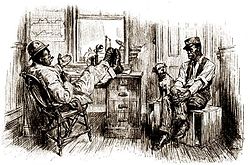Amos N Andy

Illustrator J. J. Gould's 1930 drawing of Amos (r) and Andy for New Movie Magazine
|
|
| Other names |
The Amos 'n' Andy Show 1943–1955 Amos 'n' Andy's Music Hall 1955–1960 |
|---|---|
| Country of origin | United States |
| Language(s) | English |
| Home station |
WMAQ AM NBC CBS |
| TV adaptations |
The Amos 'n' Andy Show 1951–1953 |
| Starring |
Charles Correll Freeman Gosden |
| Announcer |
Bill Hay Dell Sharbutt Harlow Wilcox Carleton KaDell Art Gilmore John Lake Ken Carpenter Ken Niles |
| Created by | Charles Correll Freeman Gosden |
| Written by | Charles Correll Freeman Gosden Joe Connelly Bob Mosher |
| Original release | March 19, 1928 – November 25, 1960 |
| Opening theme | "The Perfect Song" |
| Sponsored by |
Pepsodent Toothpaste Campbell's Soup Rinso Rexall Drugs |
Amos 'n' Andy is an American radio and television sitcom set in Harlem, Manhattan's historic black community. The original radio show, which was popular from 1928 until 1960, was created, written, and voiced by two white actors, Freeman Gosden and Charles Correll, who played a number of different characters, including the titular Amos Jones (Gosden) and Andrew Hogg Brown (Correll).
When the show moved to television, black actors took over the majority of the roles; white characters were infrequent. Amos 'n' Andy began as one of the first radio comedy series and originated from station WMAQ in Chicago. After the first broadcast in 1928, the show became a hugely popular radio series. Early episodes were broadcast from the El Mirador Hotel in Palm Springs, California. The show ran as a nightly radio serial (1928–43), as a weekly situation comedy (1943–55), and as a nightly disc-jockey program (1954–60). A television adaptation ran on CBS (1951–53) and continued in syndicated reruns (1954–66). It would not be shown to a nationwide audience again until 2012.
Amos 'n' Andy creators, Gosden and Correll, were white actors familiar with minstrel traditions. They met in Durham, North Carolina, in 1920. Both men had some scattered experience in radio, but it was not until 1925 that the two appeared on Chicago's WQJ. Their appearances soon led to a regular schedule on another Chicago radio station, WEBH, where their only compensation was a free meal. The pair hoped that the radio exposure would lead to stage work; they were able to sell some of their works to local bandleader Paul Ash, which brought them enough name recognition to be offered jobs at the Chicago Tribune's station WGN in 1925. The lucrative offer allowed them to become full-time broadcasters. The Victor Talking Machine Company also offered them a recording contract.
...
Wikipedia
